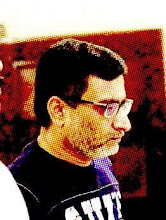This is an extract from the refreshing book on Herge's life , Herge: The Man Who Created Tintin.
1. Find a story line sturdy enough to hold for the whole course of the adventure. A simple chase connecting gags is not enough.
2. Find a story that is believable enough to seem true. Jot it down on paper, in twenty lines, maximum.
3. Divide up the story, panel by panel, plate by plate. Each page has to conclude with an element of suspense.
4. Penciling-in stage: sketch the figures with a cursory background drawn with 9-cm (3.54-in) squares on Steinbach paper measuring 51 by 36 cm (20 by 14 in) in size, within a useful format of 40 by 29.5 cm (15.75 by 11.6 in), which is to say twice as large as a book page. Divide the sheet into four strips of 9.5 by 29.5 cm (3.74 by 11.6 in ) each, separated by a blank space 6.5 cm 2.55 in) wide. (The blank areas were used as scrap paper, combining all the early versions. All sorts of notations were scribbled there: portraits, objects, landscapes, lists of names, addresses, and telephone numbers.)
5. Final drawings are copied square by square to offer a better selection and re framed and placed on another white page, which Will become the definitive plate. Touch-ups and final details are added. Copy is moved around. Herge ceaselessly sought simplification. is objective: hide the scaffolding.
6. Coloring stage: focus on the costumes and the background decor, relying on a solid base of documentation. Exactitude is required, as the settings (desert, sea, moon, jungle) aren't static.
7. The inking stage is done on Schoeller-Parole paper, with a Gillott's Inqueduct G-2 pen(made in England) of stainless steel, which can be cleaned in water and has a small ink reservoir. (Herge stocked up on these pens before the war. Thirty years later he still had a few. He used to sharpen them with a steel file to conserve them as long as possible.)
8. Photographed by the photo engraver, the black-and-white plate is transferred to transparent film accompanied by several proofs on blue-gray paper.
9. More coloring: the colors applied in flats do not take into account for bright colors, and, if necessary, gouache for opaque colors. (Herge established standard guidelines. For example, there were to be two superimposed layers for Tintin's sweater to bring out the color's full intensity.)
10. Set out the dialogues on the typewriter to gauge the exact number of letters for each vignette, to calculate, with the help of a grid, their position in the dialogue balloons. Draw in the letters. Lettering is delicate because it poses numerous problems. (At these times they also had to consider the English translators, who had to change the French Milou into "Snowy", the only acceptable name in five letters that would not exceed the line when Tintin spoke to his dog.)
11. Last, add the graphics of sound effects, which consist essentially of "Crack!" "Bang" "Bzzzz".
1. Find a story line sturdy enough to hold for the whole course of the adventure. A simple chase connecting gags is not enough.
2. Find a story that is believable enough to seem true. Jot it down on paper, in twenty lines, maximum.
3. Divide up the story, panel by panel, plate by plate. Each page has to conclude with an element of suspense.
4. Penciling-in stage: sketch the figures with a cursory background drawn with 9-cm (3.54-in) squares on Steinbach paper measuring 51 by 36 cm (20 by 14 in) in size, within a useful format of 40 by 29.5 cm (15.75 by 11.6 in), which is to say twice as large as a book page. Divide the sheet into four strips of 9.5 by 29.5 cm (3.74 by 11.6 in ) each, separated by a blank space 6.5 cm 2.55 in) wide. (The blank areas were used as scrap paper, combining all the early versions. All sorts of notations were scribbled there: portraits, objects, landscapes, lists of names, addresses, and telephone numbers.)
5. Final drawings are copied square by square to offer a better selection and re framed and placed on another white page, which Will become the definitive plate. Touch-ups and final details are added. Copy is moved around. Herge ceaselessly sought simplification. is objective: hide the scaffolding.
6. Coloring stage: focus on the costumes and the background decor, relying on a solid base of documentation. Exactitude is required, as the settings (desert, sea, moon, jungle) aren't static.
7. The inking stage is done on Schoeller-Parole paper, with a Gillott's Inqueduct G-2 pen(made in England) of stainless steel, which can be cleaned in water and has a small ink reservoir. (Herge stocked up on these pens before the war. Thirty years later he still had a few. He used to sharpen them with a steel file to conserve them as long as possible.)
8. Photographed by the photo engraver, the black-and-white plate is transferred to transparent film accompanied by several proofs on blue-gray paper.
9. More coloring: the colors applied in flats do not take into account for bright colors, and, if necessary, gouache for opaque colors. (Herge established standard guidelines. For example, there were to be two superimposed layers for Tintin's sweater to bring out the color's full intensity.)
10. Set out the dialogues on the typewriter to gauge the exact number of letters for each vignette, to calculate, with the help of a grid, their position in the dialogue balloons. Draw in the letters. Lettering is delicate because it poses numerous problems. (At these times they also had to consider the English translators, who had to change the French Milou into "Snowy", the only acceptable name in five letters that would not exceed the line when Tintin spoke to his dog.)
11. Last, add the graphics of sound effects, which consist essentially of "Crack!" "Bang" "Bzzzz".



No comments:
Post a Comment